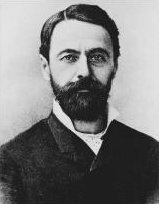Joseph Achille Le Bel facts for kids
Quick facts for kids
Joseph Achille Le Bel
|
|
|---|---|
 |
|
| Born | 28 January 1847 Pechelbronn
|
| Died | 6 August 1930 (aged 83) |
| Nationality | French |
| Known for | Stereochemistry Le Bel–Van 't Hoff rule |
| Awards | ForMemRS (1911) Davy Medal (1893) |
Joseph Achille Le Bel (born January 21, 1847, in Pechelbronn, France – died August 6, 1930, in Paris, France) was a French chemist. He is best known for his important work in a science called stereochemistry. This field helps us understand how atoms are arranged in 3D space inside molecules.
Contents
Joseph Le Bel's Big Discovery
Joseph Le Bel studied at the École Polytechnique in Paris. In 1874, he shared an exciting new idea. He believed there was a special connection between how a molecule was built and something called its "optical activity."
What is Optical Activity?
Imagine light waves traveling in all directions. When light passes through certain substances, it can twist or rotate. This twisting is called "optical activity." Le Bel realized that the way a molecule's atoms were arranged in space affected how it interacted with light.
Molecules in 3D Space
Before Le Bel, many scientists thought of molecules as flat. But Le Bel, along with a Dutch chemist named Jacobus Henricus van 't Hoff, suggested that molecules are actually 3D. They proposed that a carbon atom, which is very common in molecules, can connect to four other atoms in a specific 3D shape, like a tiny pyramid.
This idea was a huge step forward! It helped explain why some molecules, even with the same atoms, behaved differently. Their discovery laid the foundation for stereochemistry. Today, this important idea is known as the Le Bel–van't Hoff rule.
Later Life and Work
Joseph Le Bel continued his scientific work. He even wrote a book in 1929 called Cosmologie Rationelle, which means "Rational Cosmology." He passed away in 1930, leaving behind a major contribution to chemistry.

